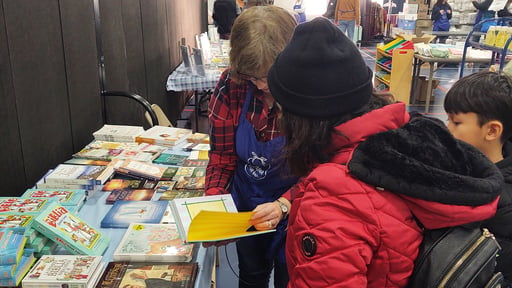We talked with the author of The Hear Me Read Bible, Dr. Mary Manz Simon, about the importance of reading with your children and letting them read to you. She also shares tips on how to get this started in your home!
How important is it for parents to not only read to their children but also let their children read to them?
Simply stated, parents who read aloud give a child a head start to success. Reading aloud actually accelerates a child’s literacy timeline.
A child listens “up” when we read aloud. This means a child listens on a higher language level than he can read by himself. Reading aloud exposes a child to more complex ideas, new vocabulary, and higher-level thinking than if he is left alone to read. Reading to a child demonstrates fluency of language and expressions of thought.
A child who reads to us opens the door to growing as a person. As we wrap conversations around reading aloud, a child moves beyond mere comprehension of the content and practice of skills to grow personally. Asking questions like “how did you feel when something similar happened to you?” invites a child to authentically engage with the content within a specific value system.
The obvious parallels between biblical figures and our children are vivid reminders of the real-time relevance of the Bible. For example, in “The Hide-and-Seek Prince,” Joash becomes king when he is seven years old. Today, some first graders have significant family responsibilities. Joash’s grandmother was a murderer; today, every seven-year-old knows how to shelter in place. Sharing a Hear Me Read story like Joash allows the listener and reader to bond more deeply to each other and God’s Word.
What is one piece of advice you would like to offer parents on teaching their young children to read?
Show your delight in reading. Take every opportunity to demonstrate that you love to read. Whether it’s cramming an extra book into luggage or talking about staying up late to read, communicate your joy of reading.
The new Hear Me Read Bible has eight stories. How did you choose which stories to highlight?
Our five grandsons vividly remind me that kids need a compelling reason to leave their screens to pick up a book. Every Hear Me Read story is action-oriented and loaded with high drama.
Ask a child, “Can an army win a battle using jars and torches for weapons?” (about “Hurray for the Lord’s Army!”) or, “What might happen to someone who says no to a king?” (about “Daniel and the Tattletales”). These stories have so much in-your-face action, a child will eagerly grab The Hear Me Read Bible!
What inspired you to write a second Hear Me Read Bible?
I was delighted when Concordia Publishing House suggested compiling the Level Two Bible stories into a single volume. What a confidence boost for a young child to read a big volume with eight stories!
Learning to read is hard work. Early in the literacy process, a child needs encouragement merely to balance a book on his lap, decipher words, and turn a page! Reading an entire Hear Me Read Bible is great affirmation and can motivate a child to read more.
How different is the Level Two book from the Level One book?
The two volumes represent a progression of skill development.
The Hear Me Read Bible Level One uses a maximum of twenty-five different words in each story. The focus is natural language, prediction, and repetition. In The Hear Me Read Bible Level Two, a child extends his initial sight vocabulary, practices foundational skills, and experiences the self-confirmation that “I can really read.”
What was the process of rewriting these Bible stories for young readers like? Did you come across any challenges?
Having earned a doctorate in early childhood education, I naturally work from a framework that reflects the five aspects of development: physical, spiritual, emotional, social, and cognitive. All content builds from this base. Even after writing books that have sold more than three million copies, I always find it a challenge to write a book children will want to read.
Was there any one story you knew needed to be included?
In the note to the adult that accompanies The First Christmas, I reflect on the importance of a single three-letter word: you. That’s appropriate, because you is one of the first pronouns a child learns to read. You is in the angel’s message to the shepherds outside Bethlehem. You is at the heart of our relationship with Jesus. The First Christmas directly delivers what life in Christ is all about: a one-on-one relationship between Jesus and you.
In the first Hear Me Read Bible, you included a note for parents to give them some background and guidance for teaching their little ones the Bible stories. Was that something you knew right away that you wanted to include in the Level Two version?
I loved writing a note to the adult for each story. It allowed me to assume the role of parent educator. As an early childhood educator, I impact not one but at least two generations. What a privilege!
Although I had great fun writing those notes for adults (really!), I am realistic. As an author, I merely put words on the page. God does everything else.





.jpg?width=50&height=50&name=IMG_20220621_160541_456%20(1).jpg)







